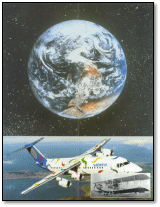1960/1980
A space odyssey
The world's two superpowers embarked on a race for supremacy in space.
The investments reflected the scale of their ambitions, the USSR achieving the
initial successes as early as 1957, with the launch of the Sputnik 1 satellite
carrying the dog Laïka and the first man to orbit the earth (Yuri Gagarin).
 Spurred into action, the USA later more than caught up with the first man on
the moon and exploration of the planets Jupiter, Mars, Neptune and Venus.
Spurred into action, the USA later more than caught up with the first man on
the moon and exploration of the planets Jupiter, Mars, Neptune and Venus.
1975. The petrol crisis and its effects on Europe : inflation and crisis.
Miniaturisation, microprocessors and optical fibres permitted new developments
in information technology and telecommunications.
Medical imaging by magnetic resonance opened up a new era for hospitals.
Some key dates
|
1960
|
-
|
Launch of the liner France.
|
|
|
|
1961
|
-
|
Vostok 1 - First manned flight to orbit the earth - Yuri Gagarin.
|
|
|
|
1964
|
-
|
BENELUX - Common court of justice.
|
|
|
|
1965
|
-
|
Inauguration of the Mont-Blanc tunnel.
|
|
|
|
1966
|
-
|
Carbon fibre
|
|
|
-
|
France leaves NATO
|
|
|
|
1967
|
-
|
The first colour TV
|
|
|
|
1968
|
-
|
2001 : A Space Odyssey, by S. Kubrick.
|
|
|
|
1969
|
-
|
Military telecommunication network, the forerunner of the INTERNET.
|
|
|
-
|
Armstrong. The first man on the moon.
|
|
|
-
|
Concorde's maiden flight.
|
|
|
|
1970
|
-
|
The Pioneer 10 probe observes Jupiter.
|
|
|
|
1971
|
-
|
Microprocessor.
|
|
|
|
1972
|
-
|
Optical fibre
|
|
|
|
1973
|
-
|
Micro-computer
|
|
|
|
1976
|
-
|
The Viking I probe lands on Mars.
|
|
|
|
1978
|
-
|
Exploration of Venus
|
|
|
-
|
Medical imaging by magnetic resonance.
|
|
|
-
|
Dropping of French parachutists on Kolwezi.
|
|
|
|
1979
|
-
|
Philips Compact Disc
|
|
|
-
|
First flight by Ariane rocket.
|
|
|
-
|
Direct elections to the European Parliament.
|
|
|
|
1980
|
-
|
Videoconference.
|
|
Market globalisation
Active participation of the CEBEC quality mark
Belgium's number one in certification, CEBEC immediately joined the various
international committees set up to facilitate exports of products worldwide.
CB SCHEME
The "Certification Body Scheme" was set up on the initiative of the
International Electrotechnical Commission (IEC), with the task of facilitating
access of products to the global market.
CEBEC immediately signed this agreement, conducting conformity tests on
electrical equipment to permit their marketing in more than 32 countries on
five continents.
CENELEC
CEBEC participated in the CENELEC studies and became a party to the CCA
(Cenelec Certification Agreement) : a mutual recognition agreement for
tests carried out by certification bodies in the member countries of the
European Economic Area.
CEBEC also attributes the CECC (Cenelec Electronic Components Committee)
certificate, recognised, after tests, for components in over 20 European
countries.
<HAR>
CEBEC awards the <HAR>, based on harmonised standards in force for PVC-or
rubber-insulated wires and cables, the production of which is subject to
continuous factory control.
ENEC
(European Norm for Electrotechnical Certification). For street lighting.
LOVAG
(Low Voltage Agreement), LOVAG for "low voltage" industrial equipment.
EMEDCA
Agreement making it possible to avoid the duplication of medical equipment
testing.
KEYMARK
For the household electrical appliance sector.
EMC Scheme
For electromagnetic compatibility.
CEBEC and Quality Assurance
EN ISO 9000 systems certification was no longer limited to the electrical and
electronic sectors, but increasingly expanding to include other fields such as
the medical and automobile sector (QS 9000).
CEBEC now helped companies introduce an environmental
protection system (ISO 14000) and/or contractual security (VCA).
CEBEC exercises its activity under the aegis of the CNR (National Council), a
Ministry of Economic Affairs body, which has three branches :
-
BELTEST for testing laboratories and control bodies
-
BELCERT for certification bodies
-
OBE (Belgian Calibration Organisation).
The Ministry of Economic Affairs is responsible for notifying CEBEC to the European Communities.
|


